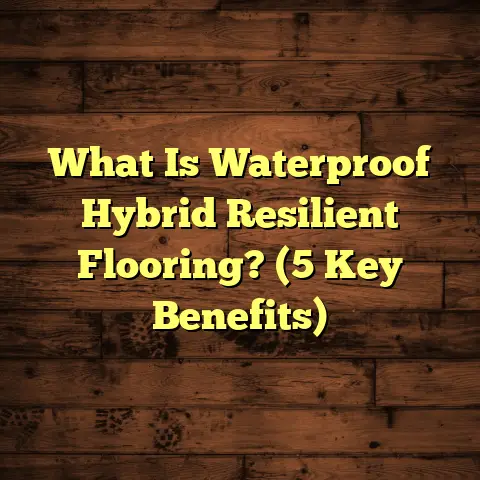What is Terrazzo Flooring? (5 Must-Know Benefits for Homeowners)
I still vividly remember the first time I walked into a building floored with terrazzo. It was an old municipal library built back in the 1930s, somewhere in the heart of the city. The floor was a sprawling canvas of tiny chips of marble and glass embedded into a gleaming surface that felt cool to the touch and sturdy beneath my feet. The intricate patterns made the whole space feel alive, yet elegant—something you don’t often find in typical flooring materials. From that moment on, I was hooked on terrazzo. Since then, I’ve had the opportunity to work on multiple projects involving this flooring type, and I’ve gathered enough knowledge and experience to share what makes it so special for homeowners.
What is Terrazzo Flooring?
Let me start by breaking down exactly what terrazzo flooring is. Essentially, terrazzo is a flooring system created by embedding pieces of stone or glass chips—called aggregates—into a binder or matrix. This binder can be cementitious (cement-based) or epoxy-based, and after curing, the surface is ground and polished to reveal a smooth, shiny finish showcasing the embedded chips.
The name “terrazzo” means “terrace” in Italian, which hints at its origins. It was first developed in Italy centuries ago by Venetian builders who used leftover marble chips from construction sites to create durable and decorative flooring surfaces for patios and terraces.
How Terrazzo is Made
The process typically involves several key steps:
- Surface Preparation: The subfloor must be clean, level, and structurally sound. This is crucial because terrazzo is quite rigid, especially cement-based varieties.
- Pouring or Placing the Mix: The binder (cement or epoxy) is mixed with the aggregate chips and poured over the prepared surface or set into forms if precast tiles are used.
- Curing: The material is left to cure for several days. Epoxy terrazzo cures faster than cementitious types, usually within 24-48 hours, while cement terrazzo may take up to 28 days to fully cure.
- Grinding: After curing, the surface is ground with diamond abrasives to expose the chips and create an even surface.
- Polishing: Multiple polishing passes with finer abrasives produce a glossy finish.
- Sealing: A protective sealant is applied to enhance durability and stain resistance.
Types of Terrazzo
There are mainly three types of terrazzo used today:
- Cementitious Terrazzo: Traditional method using cement as binder; more porous and requires sealing.
- Epoxy Terrazzo: Uses epoxy resin binder; allows for more vibrant colors and thinner applications.
- Polyurethane Terrazzo: A newer option with high durability and chemical resistance but less common in residential settings.
Dimensions and Thickness
Terrazzo flooring thickness varies depending on application:
- Cement terrazzo floors typically range from 3/4 inch (19 mm) to 1 inch (25 mm).
- Epoxy terrazzo can be installed thinner, around 1/4 inch (6 mm) to 3/8 inch (10 mm).
The thinner epoxy variants make it possible to apply terrazzo over existing floors in renovations without raising floor height too much.
Cost Considerations
Terrazzo is generally more expensive than many standard flooring options but offers unmatched longevity. Installation costs average between $20 and $50 per square foot. This range depends heavily on factors like:
- Choice of binder (cement vs epoxy)
- Type and size of aggregate
- Complexity of design or pattern
- Labor rates in your area
- Surface preparation needs
For example, in metropolitan areas like New York City or Los Angeles, labor costs push prices toward the higher end of the scale. Conversely, smaller cities may see costs closer to $20-$30 per square foot.
Lifespan and Durability
What’s impressive about terrazzo is its lifespan. Properly installed and maintained terrazzo floors can last between 40 to 100 years. Some public buildings constructed early last century still sport original terrazzo floors that look stunning today!
My Journey with Terrazzo Flooring
When I renovated my home five years ago, I wanted a floor that would withstand heavy traffic but also look beautiful at the same time. Hardwood was tempting but seemed prone to scratches and moisture damage with pets running around. Carpet was out of the question due to allergies.
A friend recommended terrazzo based on her experience with it in her kitchen remodel. After some research, I decided on epoxy terrazzo for its color flexibility and ease of maintenance.
The local contractor prepared our concrete slab first—a critical step I learned about during the project. They poured a mix of white epoxy resin embedded with marble chips about 1/4 inch thick throughout the 500-square-foot kitchen and entryway.
The whole installation took roughly two weeks due to curing times and multiple grinding/polishing steps. Watching those machines slowly reveal the glossy speckled pattern was quite satisfying! Since then, I’ve appreciated how easy it is to clean—just a quick sweep and mop keeps it looking fresh even after five years.
5 Must-Know Benefits of Terrazzo Flooring for Homeowners
After working with terrazzo on my own home projects and those of clients, these five benefits stand out the most.
1. Incredible Durability Makes It Worth Every Penny
You don’t need me to tell you that flooring takes a beating—kids running around, pets scratching surfaces, spills galore. Terrazzo handles all that without cracking or chipping easily thanks to its composite material strength.
It’s resistant not only to impact but also abrasion from shoes and furniture movement. This makes it ideal for entryways, kitchens, hallways—anywhere with heavy foot traffic.
Data point: According to the National Terrazzo & Mosaic Association (NTMA), properly installed terrazzo floors have an average lifespan exceeding 75 years under normal residential use.
2. Custom Designs Let You Show Off Your Style
One reason I love terrazzo is how creative you can get with it. You aren’t stuck with plain colors or repetitive tile patterns.
Aggregates come in various sizes—from tiny chips less than 1/8 inch wide to larger chunks over 1/2 inch—and materials like marble, glass, quartz, or even semi-precious stones.
Colors can be tailored by choosing different binders or pigmenting epoxy resins. Whether you want subtle earth tones or vibrant blues and greens like my floor, options abound.
Example: A client from Miami wanted a custom beach-themed terrazzo floor featuring turquoise glass chips mixed with white marble in an intricate wave pattern covering 800 square feet of their living room. It took three weeks to complete but became a focal point admired by everyone.
3. Environmentally Friendly Flooring Option
In a world where sustainability matters more each year, terrazzo shines as an eco-conscious choice.
Many manufacturers use recycled glass or stone aggregates sourced from demolition waste or industrial byproducts instead of newly quarried materials.
Because terrazzo floors last so long (often over half a century), they reduce the need for frequent replacement—cutting down on waste sent to landfills compared to carpet or vinyl that need replacing every decade or so.
Also, epoxy binders emit fewer volatile organic compounds (VOCs) than many synthetic flooring adhesives.
4. Low Maintenance Means More Time Enjoying Your Home
Cleaning terrazzo couldn’t be simpler—just sweep daily or vacuum dirt/dust away then mop with mild detergent when needed.
No harsh chemicals are required since its non-porous surface resists stains and bacterial buildup naturally.
From my experience, this low-maintenance aspect saves homeowners hundreds of dollars annually compared to carpet cleaning or hardwood refinishing costs.
Professional tip: Applying a sealant every 1-2 years keeps your terrazzo floors resistant to stains and maintains shine longer.
5. Adds Significant Value When Reselling Your Home
Terrazzo floors aren’t just pretty—they’re an investment that pays off when selling your home.
According to Remodeling Magazine’s 2023 Cost vs. Value report, homes upgraded with premium flooring materials like terrazzo see returns up to 80% of installation cost at resale.
In luxury neighborhoods such as Beverly Hills or Manhattan’s Upper East Side, terrazzo floors are often highlighted in listings as a sign of quality craftsmanship and attention to detail—a factor that draws discerning buyers willing to pay a premium.
Diving Into Data: Terrazzo Flooring by Numbers
Numbers often help clarify decisions better than words alone. Here are some useful figures based on my research and experience:
| Aspect | Data / Range |
|---|---|
| Installation cost | $20 – $50 per sq.ft |
| Lifespan | 40 – 100 years |
| Thickness | 6 mm (tiles) – 25 mm (poured) |
| Maintenance frequency | Sweep daily; mop weekly; reseal every 1-2 years |
| Return on investment | Up to 80% at resale |
| Average installation time | 1 – 3 weeks |
Case Study: Residential Terrazzo Install
I recently helped design an epoxy terrazzo floor for a client’s open-plan living space covering 1200 square feet in Chicago.
- Chose green marble chips mixed with white epoxy binder.
- Cost: $38 per sq.ft including labor/materials.
- Installation timeline: Two weeks.
- Result: Floor remains pristine after three years with minimal upkeep despite heavy family use including small children and pets.
This project reaffirmed how terrazzo combines beauty with practicality perfectly.
How Does Terrazzo Compare With Other Flooring?
You might ask: “How does terrazzo stack up compared to hardwood, tile, laminate or vinyl?” Here’s my straightforward take based on long experience:
| Flooring Type | Pros | Cons |
|---|---|---|
| Terrazzo | Extremely durable; customizable; low maintenance; eco-friendly | Higher upfront cost; skilled installation required |
| Hardwood | Warmth; natural look | Prone to scratches; moisture sensitive; needs refinishing |
| Laminate | Affordable; easy install | Less durable; can warp; not eco-friendly |
| Tile | Durable; water resistant | Grout requires cleaning; tiles can crack |
| Vinyl | Cost-effective; water resistant | Shorter lifespan; can fade or peel over time |
While hardwood offers warmth and character, it doesn’t stand up well in wet or high traffic areas compared to terrazzo’s toughness. Tile shares water resistance but grout lines trap dirt easier than seamless terrazzo surfaces.
Vinyl’s affordability appeals but it won’t last decades like terrazzo does without replacement.
Installation Insights: What You Should Expect
If you’re thinking about installing terrazzo at home, here’s what you’ll want to know about the process:
Subfloor Preparation Is Key
Before pouring any material, your existing floor must be strong and level. Concrete slabs often need patching or grinding down any uneven spots first.
If installing over wood subfloors (less common), extra reinforcement might be necessary due to terrazzo’s rigidity.
Choosing Between Epoxy vs Cementitious Terrazzo
Epoxy sets faster (1-2 days) versus cementitious which takes weeks and requires longer curing times before polishing.
Epoxy allows thinner layers (~6 mm), vibrant colors, and better stain resistance but comes at slightly higher cost.
Cementitious options are thicker (~19 mm), more traditional-looking but more porous needing regular sealing.
Grinding & Polishing Takes Time
After curing, grinding machines fitted with diamond abrasives smooth out the surface and expose aggregates fully.
This step usually involves multiple passes—from coarse grinding down to fine polishing—to achieve that glossy finish homeowners love.
Sealing Protects Your Investment
Sealing helps prevent stains from oil spills, wine, or other household accidents. It also prolongs shine between polishings.
A professional installer will recommend best sealants suited for either epoxy or cementitious types.
My Personal Tips for Maintaining Terrazzo Floors
Based on years of experience both personally and professionally:
- Sweep daily with microfiber dust mop.
- Mop weekly using pH-neutral cleaner diluted in warm water.
- Avoid abrasive scrubbing pads or harsh chemical cleaners.
- Place rugs near entrances to reduce grit abrasion.
- Schedule professional resealing every couple years depending on wear.
- If chips appear loose or cracks develop (rare), call professional restoration services promptly.
Frequently Asked Questions About Terrazzo Flooring
Is terrazzo slippery when wet?
It can be if polished highly smooth without any anti-slip treatment. However, adding fine aggregate textures during installation or applying anti-slip coatings can reduce risk significantly.
Can I install terrazzo over existing flooring?
Usually yes if subfloor is suitable—epoxy terrazzo especially works well as an overlay on concrete or tile floors due to thin application thicknesses.
How long does installation take?
Typically between one to three weeks depending on project size and type of terrazzo used.
Is terrazzo cold underfoot?
Yes, as it’s made from stone materials it tends to feel cool which is wonderful in warmer climates but may require area rugs elsewhere for comfort.
What kind of repairs does terrazzo need?
Very minimal if installed correctly; occasional resealing suffices for maintenance unless there’s structural movement causing cracks.
Wrapping Up My Thoughts on Terrazzo Flooring
Choosing flooring is one of those decisions that affects your home’s look, feel, and functionality for decades ahead. After working extensively with various options over the years, I find terrazzo stands out as a rare blend of artful design and rock-solid performance.
Its longevity means you won’t worry about replacing floors anytime soon—a huge relief given how disruptive renovations can be!
The ability to customize colors and patterns lets you express personality uniquely rather than settling for generic options sold at big-box stores.
Low maintenance means less time cleaning and more time enjoying your space without worrying about damage from kids or pets.
Finally, knowing it adds value when selling your home gives peace of mind that you’re investing wisely—not just spending on fleeting trends.
If you’re ready for flooring that tells a story underfoot while serving up practical benefits daily, terrazzo deserves serious thought. Whether you choose classic cement-based styles or modern epoxy variants packed with recycled glass chips for color pop—you’ll have something truly special beneath your feet for years to come.
Got questions about your specific project size? Want help estimating costs? I use tools like FloorTally regularly for accurate local quotes tailored precisely to room dimensions—just ask!
Would you like me to help create a budget estimate using FloorTally? Or perhaps provide advice on selecting installers near your location? Feel free to reach out anytime—I’m here to help make your flooring journey smooth and satisfying!





